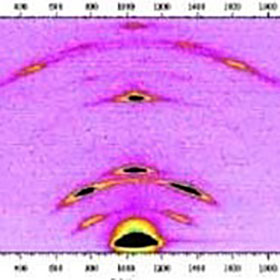Small- and wide-angle X-ray scattering (SAXS and WAXS)
This technique is used to reveal order / disorder at large, micro or nano scale in non-crystallized materials: i.e. polymers, proteins in solutions, oil, colloids, and plastic.
A typical experimental set-up requires a highly collimated X-ray source and a detector with photon counting sensitivity as the intrinsic process behind small angle x-ray scattering is very inefficient. Ideally both small angle and wide angle detectors are combined in order to characterize simultaneously short and longer ranges of scattering vectors.
For instance, WAXS will be used to determinate the degree of crystallinity of polymer samples. SAXS is capable of delivering structural information of macromolecules between 5 and 25 nm with averaged particle sizes, shapes, distribution, and surface-to-volume ratio, of repeat distances in partially ordered systems of up to 150 nm. USAXS (ultra-small angle X-ray scattering) can resolve even larger dimensions.
SAXS WAXS patterns consist of low intensity patterns acquired over minutes of integration requiring very low background noise and good signal discrimination. Coexistence of bright and very bright signals on the same image could require dynamic range up to 106:1 using multiple exposures.
Large area detectors up to 165mm diagonal and 16 megapixel resolution are used in synchrotrons whereas smaller input size detectors: typically 90mm and 16 megapixel resolution are used with laboratory sources.
We Recommend...
X-ray sCMOS 64 MP Detector

Contact Us
22 Theaklen Drive,
Saint Leonards-on-sea,
TN38 9AZ,
United Kingdom


